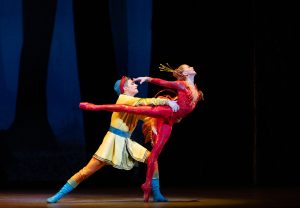
On a recent Saturday evening, Miami City Ballet’s performance began pre-curtain with the music of The Firebird filling the Kravis Center in West Palm Beach.
It was pleasing to sit back and let all your thoughts fall away as the live music rose from the orchestra pit. Looking up at the stage, there was a glorious, gigantic tapestry that reached to the full height of the proscenium. It felt as though an enormous and ancient Russian fairytale book had opened, revealing a gorgeous, richly saturated drawing of the magical tale that was about to unfold. It was an absolute feast for the eyes and ears, and this was just the beginning of what was still to come.
Wendall K. Harrington, the creative director; Anya Klepikov, the sets and costumes designer; and James F. Ingalls, the lighting designer successfully collaborated on every visual detail to make the staging for Miami City Ballet’s production of Firebird an absolute delight to behold, a classical ballet retold with with the magic that today’s technical staging can create.
George Balanchine choreographed Firebird in 1949 to feature his then-wife, ballerina Maria Tallchief. The costumes and sets were designed by artist Marc Chagall. Balanchine reworked the choreography a few more times to accommodate different ballerinas in the role of the firebird, and in the version that Miami City Ballet performs, he choreographed with Jerome Robbins, who created the lively “monster” scene with Kastchei the Wizard and his subjects.
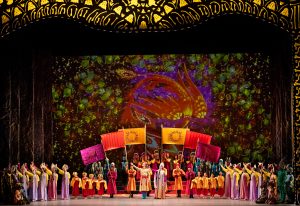
As the opener for the Winter Mix program, the elaborate Firebird production that MCB commissioned in 2020 was truly impressive. The cast of 71 was composed of company members in the lead roles and numerous ballet students from the company’s school dancing to the 1945 version of Stravinsky’s score. The Firebird, which dates to 1910, was the very first score Stravinsky composed for ballet and at the Feb. 3 performance, it was enthusiastically played by the Miami City Ballet Orchestra (formerly known as Opus One Orchestra) under the baton of the company’s principal conductor and music director Gary Sheldon.
Dawn Atkins, who was recently promoted to principal dancer, debuted in her role as the magical firebird. Dressed from headpiece to pointe shoes in glittery red with a tailpiece of long red feathers, Atkins’ performance was technically strong but her character had a somewhat detached manner even as she was captured and then released by Prince Ivan (Cameron Catazaro).
In gratitude for her freedom, Atkins gave the prince a magic feather that would call her to his aid whenever he was in dire need. As Catazaro returned to his hunt, he came upon 12 captured maidens, wearing lace folkloric headpieces and dressed in billowing long dresses in an array of shades of pink to lavender. With them was also a beautiful princess in dark rose (elegantly danced by Jordan-Elizabeth Long) with whom the prince immediately fell in love. But — of course — there was a wicked wizard and an army of amusingly costumed “monsters” that Catazaro needed to conquer in order to release the princess and her maidens. Together with the help of the magical firebird, evil was vanquished and in no time at all, the wedding began. Things happen quickly in fairytales.
The splendor and the slow moving, regal pageantry of the wedding finale was a splendid end to the ballet. The huge cast, costumed in lush fabrics, crossed in slow processions in front of the wedding couple as waving banners flew high in front of a dazzling projection of a giant, golden sun.
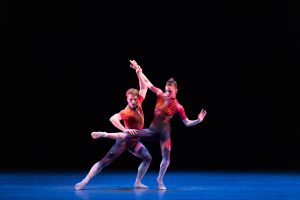
This Winter Mix program had a similar form to the season’s first program Fall Mix. Both had a centerpiece that was a brand-new work — this time by not one but two upcoming local choreographers. Both programs were gift-wrapped with an opening and closing work by world-renowned choreographers.
Choreographer Margarita Armas, in her second work for MCB, chose some unusual sounds/music for the three sections of her work Análogo — “Forest Scene,” by Aukai (aka Markus Sieber), Nina Simone singing Cole Porter and “Tones of Longing,” by Miss Meadow. There was a sparseness to the whole piece. Five couples, dressed in painted dancewear costumes by Spiridonadou (which helped to pair the dancers), performed the lean choreography that included a lot of walking in and out, sometimes receding into the background and then reappearing through the smoky haze.
Hannah Fischer and Renan Cerdeiro moved like one in their unison movement to haunting, almost eerie music. Newcomers to the company Anna Greenberg and Alexander Kaden seemed more engaged in the work and made their presence felt as they interpreted the movement.
Presenting his fourth work for MCB, Durante Verzola choreographed a pleasant enough ballet called Paganini in Play. Using selections from two string quartets (Nos. 3 and 7) composed by Niccolò Paganini, Verzola presented a diluted Balanchinesque work with four movements.
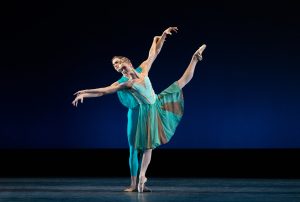
The string quartet — Mei Mei Luo on violin, Geremy Miller on violin, Michael O’Gieblyn on viola and Ashely Garritson on cello — sat on a raised platform upstage as the dancers strolled in and out and watched each other dance. The two movements that stood out were the “Minuetto: Adantino” with the trio of Samantha Hope Galler, Ashley Knox and Nicole Stalker, and the “Finale: Prestissimo,” where the lovely Adrienne Carter was paired with the speedy duo of Satoki Habuchi and Alexander Peters, who danced with high-spirited energy and sparkling technique.
Concerto DSCH was a brilliant end to the evening. The company was in excellent form, dancing up a storm with freshness, energy and technical ease. Choreographed by Alexei Ratmansky, one of today’s leading classical choreographers, Concerto DSCH was first performed by MCB in 2018 and has clearly become an outstanding vehicle for the company dancers to really shine. With masterful craftsmanship, the choreography engaged, developed and delighted with its musicality, inventiveness and construction. The warm colors of the lighting by Mark Stanley and attractive costumes by Holly Hynes complemented and enhanced the choreography which playfully interpreted Dmitri Shostakovich’s Second Piano Concerto.
Peters and Habuchi were again paired, but this time with Stalker, who, though she lacked the same clarity as her dueling duo, had a most engaging stage personality. There was a humorous moment in this charming and playful trio when the three got caught doing sauté arabesques in between the other two like a ball being repeatedly bounced back and forth. Another memorable moment (which made me chuckle) was the entire cast taking turns doing this odd, cartoonish, flex-foot rebound jump — over and over again — with Chase Swatosh centerstage doing an endless series of them.
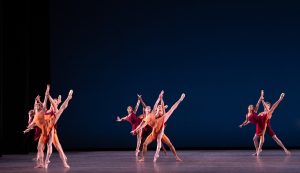
The long-limbed and elegant Fischer and her equally long-limbed and elegant partner Catazaro were beautifully matched in their duets. The partnered movement looked as if the two were ice skating and Fischer had lovely fluid transitions in and out of her lifts.
It was gutsy to present the works of upcoming young choreographers together on a program with such proven master dance makers as Balanchine, Robbins and Ratmansky. We know that audiences today like having variety in the repertory being presented, and since these two world premieres were so different in mood, the program flowed. However, after seeing the works performed side by side, it was very clear that what gave depth to the Winter Mix programming were Firebird and Concerto DSCH.